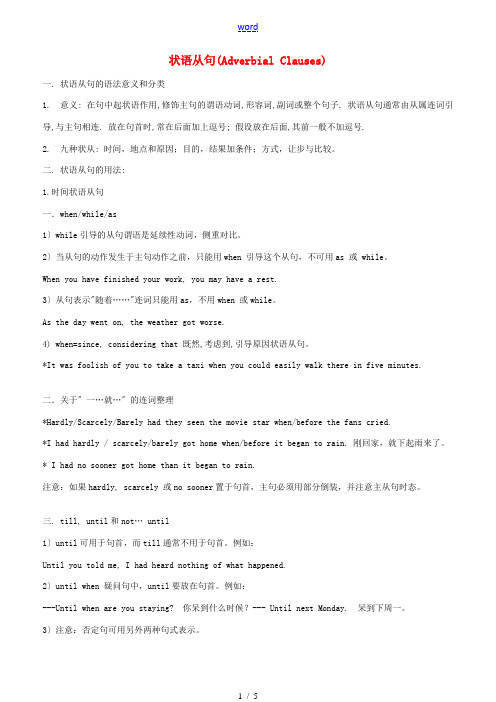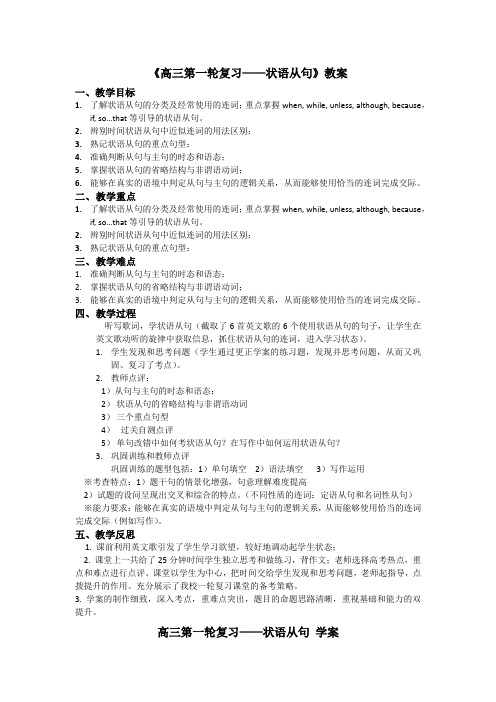高考英语一轮复习教案: 语法梳理 状语从句汇编
高三英语一轮复习 专题《状语从句》教案-人教版高三全册英语教案

状语从句(Adverbial Clauses)一. 状语从句的语法意义和分类1. 意义: 在句中起状语作用,修饰主句的谓语动词,形容词,副词或整个句子. 状语从句通常由从属连词引导,与主句相连. 放在句首时,常在后面加上逗号; 假设放在后面,其前一般不加逗号.2. 九种状从: 时间,地点和原因;目的,结果加条件;方式,让步与比较。
二. 状语从句的用法:1.时间状语从句一.when/while/as1〕while引导的从句谓语是延续性动词,侧重对比。
2〕当从句的动作发生于主句动作之前,只能用when 引导这个从句,不可用as 或 while。
When you have finished your work, you may have a rest.3〕从句表示"随着……"连词只能用as,不用when 或while。
As the day went on, the weather got worse.4) when=since, considering that 既然,考虑到,引导原因状语从句。
*It was foolish of you to take a taxi when you could easily walk there in five minutes.二.关于〞一…就…〞的连词整理*Hardly/Scarcely/Barely had they seen the movie star when/before the fans cried.*I had hardly / scarcely/barely got home when/before it began to rain. 刚回家,就下起雨来了。
* I had no sooner got home than it began to rain.注意:如果hardly, scarcely 或no sooner置于句首,主句必须用部分倒装,并注意主从句时态。
高三第一轮复习语法——状语从句

《高三第一轮复习——状语从句》教案一、教学目标1.了解状语从句的分类及经常使用的连词;重点掌握when, while, unless, although, because,if, so…that等引导的状语从句。
2.辨别时间状语从句中近似连词的用法区别;3.熟记状语从句的重点句型;4.准确判断从句与主句的时态和语态;5.掌握状语从句的省略结构与非谓语动词;6.能够在真实的语境中判定从句与主句的逻辑关系,从而能够使用恰当的连词完成交际。
二、教学重点1.了解状语从句的分类及经常使用的连词;重点掌握when, while, unless, although, because,if, so…that等引导的状语从句。
2.辨别时间状语从句中近似连词的用法区别;3.熟记状语从句的重点句型;三、教学难点1.准确判断从句与主句的时态和语态;2.掌握状语从句的省略结构与非谓语动词;3.能够在真实的语境中判定从句与主句的逻辑关系,从而能够使用恰当的连词完成交际。
四、教学过程听写歌词,学状语从句(截取了6首英文歌的6个使用状语从句的句子,让学生在英文歌动听的旋律中获取信息,抓住状语从句的连词,进入学习状态)。
1.学生发现和思考问题(学生通过更正学案的练习题,发现并思考问题,从而又巩固、复习了考点)。
2.教师点评:1)从句与主句的时态和语态;2)状语从句的省略结构与非谓语动词3)三个重点句型4)过关自测点评5)单句改错中如何考状语从句?在写作中如何运用状语从句?3.巩固训练和教师点评巩固训练的题型包括:1)单句填空2)语法填空3)写作运用※考查特点:1)题干句的情景化增强,句意理解难度提高2)试题的设问呈现出交叉和综合的特点。
(不同性质的连词:定语从句和名词性从句)※能力要求:能够在真实的语境中判定从句与主句的逻辑关系,从而能够使用恰当的连词完成交际(例如写作)。
五、教学反思1. 课前利用英文歌引发了学生学习欲望,较好地调动起学生状态;2. 课堂上一共给了25分钟时间学生独立思考和做练习,背作文;老师选择高考热点,重点和难点进行点评。
高三英语大一轮复习讲义 语法知识 专题八 状语从句 新人教版

专题八 状语从句、定语从句状语从句一、时间状语从句1.before 引导的从句中不用否定式谓语。
常用如下句型: It is long before...(过了好久才……) It is not long before...(过了不久就……)2.since 后面所用动词不同,该动词所表示动作持续时间的计算方法也不同。
⎩⎪⎨⎪⎧since +瞬间动词过去式从该动作发生时算起since +持续性动词过去式从动作结束时算起It is two years since he joined the army. It is two years since he smoked. 二、地点状语从句多由where 和wherever 引导。
Where there is a will ,there is a way. 二、原因状语从句在表示原因时,because 语气最重,其次是as ,since ,now that ,故在回答why 问句或者在强调句对原因进行强调时,只能用because 。
for 是并列连词,表示推测的理由或者进一步说明,不能放在句首,for 前要用逗号。
—Why were you absent? —Because I was ill. 三、目的状语从句1.so that/in order that 引导的目的状语从句中的谓语动词多用can/could/may/might/will/would +动词。
Please turn off the light so that I can go to sleep. 2.for fear that ,in case ,lest 表示“以防,免得”。
He is working hard for fear that he should fail. 四、条件状语从句1.providing/provided (that)假如,假若Providing (that) no one has further questions ,the meeting will be over. 2.on the understanding that =on condition that 在……条件下I give you money on the understanding that you finish your homework.五、结果状语从句注意such 引导的结果状语从句与定语从句的区别。
高三英语一轮复习 状语从句(一)教学案

个性备课
(学生记录部分)
装订线
While I understand what you say,I can't agree with you.____ ____________________
3.as表“(正当)……的时候”或“随着”。如:
As time passed,things seemed to get worse.______________________________
(2)while表对比,意为“却,但是,然而”,用于强调两种情况、活动之间的差别。如:
That region has plenty of natural resources while this one has none.__________________
(3)while可用来表“虽然,尽管”,相当于although,引导从句时while常放于句首。如:
③sb. had just done sth. when...如:
I was thinking of this when I heard my name called._________________________________
He was on the point of leavi ng when someone knocked at the gate.______________
I had hardly got home when it began to rain.
=____ _____ ______ ______home when it began to rain.
三.before和since
1.before表还未……就……;不到……就……;……才……;趁;还没来得及
高三英语一轮复习状语从句+学案

一轮复习状语从句复习学案Part 1 考点清单状语从句在句子中起状语的作用,可用来修饰主句或主句中的动词、形容词或副词。
与定语从句、名词性从句一样,状语从句通常有引导词。
1.时间状语从句:when/while/as_____________; before_________, after ___________; since__________; till/until_______; once____________; as soon as/no sooner...than/hardly...when.../scarcely...when...___________________ directly/immediately____________; the moment/the minute/the instant _____________; any time____________________ the first time___________; each time_____________2.条件状语从句:if__________; unless____________;as/so long as____________; in case ____________;given that___________; on condition that/providing that/provided that/supposing that_____________________3.原因状语从句:because/as/since _____________; now that ___________; in that _____________;seeing that/considering that____________4.让步状语从句:though/although/as/while_____________; even if/even though_____________;whether...or__________疑问词+ever/no matter+疑问词___________5.目的状语从句:so that/in order that _____________; in case/for fear that/lest_______________6.结果状语从句:so that_____________; so...that/such...that________________7.方式状语从句:as_____________;as if/as though____________8.比较状语从句:as...as_____________;than____________; The+比较级..., the+比较级...____________________9.地点状语从句:where________;wherever____________Part 2 重难点突破1.when与while---when引导时间状语从句可表示主句动作与从句动作同时发生,也可以表示从句动作与主句动作先后发生。
高考英语一轮复习 状语从句学案

在复合句中作状语的从句叫状语从句。
状语从句有时间、地点、原因、目的、结果、条件、方式、比较、让步等种类。
一、时间状语从句引导时间状语从句的连接词有: when, as, while, after, before, since, ever since, as soon as, once, till, until, whenever, no sooner…than, hardly/scarcely...when, themoment/minute/instant/second, every time, each time, any time, the first time, next time, last time, all the time, by the time, directly, immediately, instantly等。
1.表示“一···就···”的句型1) as soon as/onceAs soon as he arrives, I'll call you.他一到,我就给你打电话。
(as soon as 侧重时间或动作先后衔接紧,而once侧重条件,表示“一旦...”)2) on doing sth/on one's + n.作时间状语On arriving at the station, the thief was arrested.一到达车站,这个小偷就被逮捕了。
On his arrival in Paris, he was recognized as a noble and thrown into prison. 他一到达巴黎,就被认出是一个贵族,并被投入监狱。
3) no sooner ...than , hardly/scarcely...when它们表“一…就”。
结构中的否定词放在句首时,主句要倒装。
状语从句-备战2022年高考英语一轮复习词法、句法、语法系统精讲

专题14 状语从句考点详解【命题解读】状语从句是高考的常考点。
虽然高考全国卷不是每年必考,但是在地方卷中也是频繁出现。
无论在全国卷还是地方卷,长难句的构成嗯一定离不了状语在阅读中一定少不了状语从句的存在。
【命题预测】预计2022年高考对状语从句的考查仍然以上下文逻辑意思考查为主。
在语法填空中,以不给提示词形式命题。
在阅读理解中会以细节理解题的形式出现。
在完形填空中以长难句理解来体现,七选五中侧重上下文的逻辑联系。
【复习建议】1.掌握状语从句的概念2.掌握状语从句的引导词的用法和含义3..在习题训练中培养和提高分析句子结构的能力以及逻辑理解能力。
考点一从属连词和状语从句状语从句连词时间状语从句when, while, as, before, until, since, as soon as, the moment原因状语从句because, as, since让步状语从句although, as, while, even though/if, no matter+疑问词等目的状语从句in order that, so that, in case结果状语从句so……that, such……that, so that地点状语从句where, wherever条件状语从句if, unless, so/as long as方式状语从句as, as if/through比较状语从句as, than一、时间状语从句1.when, while, as 引导的时间状语从句(1)when 表示“当……时;在……期间”。
①When I was a little boy, I used to climb mountains on Sundays.当我小时候时,星期天常常去爬山。
(2)while 表示“在……期间”,从句中常用延续性动词。
②Please don't talk so loud while others are studying.在别人学习的时候,请别这么大声音说话。
2022届高考英语第一轮语法状语从句专题教案

2022届高考英语第一轮语法状语从句专题教案XX年高三一轮复习金子般的学案语法部分:状语从句(新人教版)状语从句是一个句子充当另一个句子的状语,表示主句动作发生的时间、条件、原因、方式、结果、目的等等。
状语从句是历年高考题的重点、难点。
命题一般是考查学生连词的掌握情况,根据两个句子的意思,判断两个句子之间的逻辑关系,选择合适的连词。
常见的状语从句有九大类。
要牢记不同的连词的具体意思,是解题的关键。
一、时间状语从句常见连词: when / while / as; before / after; since; until; as soon as / immediately / instantly / themoment / the minute / the second; no sooner…than/ hardly…when; the first time / every time / each time / next time 【完成例句】(1)我正在做饭,这时,门铃响了。
i was doing some cooking when the doorbell rang.[ ]=the doorbell rang when i was doing some cooking.(2)我正要下班,这时,天开始下大雨了。
i was about to leave work when it began to rain heavily.【结论1】when 通常意思为:当……时候;正在那时……【完成例句】[ ](3)你在北京期间能否给我收集一些红树叶?while you are in beijing, can you collect some red leaves for me?(4)那个男孩在过马路时被迎面驶来的小轿车撞了。
while walking across the street, the boy was knocked over by a running car.【结论2】 while从句只能用延续性动词,意思为:在……期间。
高三英语一轮复习-状语从句2教学案

7.(2013·江苏高考)I.th.globa.economy..ne.dru.fo.cancer. _____.i.i.discovered.wil.creat.man.economi.possibilitie.aroun.th.world.A.whateverB.whoeve...C.whereverD.whichever【解题关键】1.熟记让步状语从句的从属连词although.though. as.eve.though.eve.if等的含义。
2.牢记下列特殊情况.(1)when和while引导让步状语从句, 意思是“尽管”或“虽然”。
while用在句首, when常用在句中。
Whil..understan.wha.yo.say..can’.agre.wit.you.(2)“No matter+疑问词”引导让步状语从句时, No matter+疑问词=疑问词+-ever。
Whatever/N.matte.wha.happened.h.woul.no.mind.注意: “疑问词+-ever”还可以引导名词性从句, 此时不能与“No matter+疑问词”互换。
.wil.giv.th.boo.t.whoeve.need.it.(3)引导倒装的让步状语从句通常用as和though, 但不能用alt hough, 且as引导的让步状语从句必须倒装。
Poo.though/a..am..ca.affor.it.(4)whether...o.not也可引导让步状语从句。
Whethe.yo.believ.i.o.not.i.i.t rue.Whether you believe it or not, it is t rue.集体备课部分(学生活动部分)个性备课部分/学生记录装订线考点5 其他状语从句【典例】 1.(2015·浙江高考._____..singl.wor.ca.chang.th.meanin.o..sentence..singl.sentenc.ca.chang.th.meanin.o..pa ragraph.A.Jus.asB.Eve.thoug..C. UntilD.Unless2.(2015·安徽高考._____.h.onc.fel.lik.givin.up.h.no.ha.th.determinatio.t.pus.furthe.an.kee.o.going.A.sinceB.whenC.thatD.before课后作业:1.完成一张限时训练2.背诵3500词unit45. 课堂反思/学生总结:。
高考英语一轮复习语法专题状语从句复习讲含解析新人教版必修3202112121119

2021年高考英语一轮复习语法专题状语从句复习讲含解析新人教版必修3202112121119一、考点梳理。
1.考查in case引导的状语从句依照语境的不同,in case既可表示“假如”、“万一”,引导条件状语从句:也可表示“以防(万一)”,引导目的状语从句。
【例】 Leave your key with a neighbor____you lock yourself out one day.A. ever sinceB.even ifC.soon afterD. in case答案为D。
in case在此引导目的状语从句。
句意为:给你的邻居留一把钥匙,以防哪天你把自己锁在别处。
【例】My parents live in a small village. They always keep candles in the house__there is a power cut.A. ifB.unlessC.in caseD. so that答案为C。
in case在此引导目的状语从句,意为“以防”。
2.考查before引导的状语从句专门要注意“It+be+--段时刻+before...”这一句型。
【例】 The field research will take Joan and Paul about five months; it will be a long time____we meet them again.A. afterB.beforeC.sinceD.when答案为B。
it will be a long time before...的意思是“要过专门久才会……”。
【例】He was told that it would be at least three more months____he could recover and return to work.A. whenB.beforeC.sinceD. that答案为B it was some time before...的意思是“在……之前过了一段时刻”,通常可转译为“过了一段时刻才……”。
高三英语教案:《状语从句复习》教学设计

高三英语教案:《状语从句复习》教学设计本文题目:高三英语复习教案:状语从句复习教案【备考策略】一、地点状语从句地点状高考资源网语从句通常由where, wherever 引导。
Where I live there are plenty of trees.我住的地方树很多。
Wherever I am I will be thinking of you.不管我在哪里我都会想到你。
二、方式状语从句方式状语从句通常由as, (just) as …so …, as if, as though引导。
1) as, (just) as …so …引导的方式状语从句通常位于主句后,但在(just) as …so …结构中位于句首,这时as从句带有比喻的含义,意思是“正如… “,“就像“,多用于正式文体,例如:Always do to the others as you would be done by.你希望人家怎样待你,你就要怎样待人。
As water is to fish, so air is to man.我们离不开空气,犹如鱼儿离不开水。
Just as we sweep our rooms, so we should sweep backward ideas from our minds.正如打扫房屋一样,我们也要扫除我们头脑中落后的东西。
2) as if, as though两者的意义和用法相同,引出的状语从句谓语多用虚拟语气,表示与事实相反,有时也用陈述语气,表示所说情况是事实或实现的可能性较大。
汉译常作“仿佛… …似的“,“好像… …似的“,例如:They completely ignore these facts as if (as though) they never existed.他们完全忽略了这些事实,就仿佛它不存在似的。
(与事实相反,谓语用虚拟语气。
)He looks as if (as though) he had been hit by lighting.他那样子就像被雷击了似的。
- 1、下载文档前请自行甄别文档内容的完整性,平台不提供额外的编辑、内容补充、找答案等附加服务。
- 2、"仅部分预览"的文档,不可在线预览部分如存在完整性等问题,可反馈申请退款(可完整预览的文档不适用该条件!)。
- 3、如文档侵犯您的权益,请联系客服反馈,我们会尽快为您处理(人工客服工作时间:9:00-18:30)。
状语从句(一)时间状语从句时间状语从句1.when, while, as的区别这三个词都可以用作连接词,表示时间关系,但有所区别。
(1)when表示时间关系时,意思常常是“当(在)……的时候”。
主句和从句中的动作或事情可以同时发生,也可以先后发生。
例如:When we were at school, we went to the library every day.我们在求学的时候,每天都到图书馆去。
(2)while 用作连接词表示时间关系时,意思也是“当(在)……的时候”,主句中的动作或事情在从句中的动作或事情的进展过程中发生。
它有时可与when通用,但它只能指一段时间(a period of time),而不能指一点时间的(a point of time)。
如上面第一个例句中的when,可以用while代替;而第二个例句中的when,就不能用while代替。
例如:Please don’t talk so aloud while others are working.别人在工作的时候,请勿大声讲话。
(3)as用作连接词表示时间关系时,意思也是“当(在)……时候”,往往可与when 或while通用,但它着重指主句和从句中的动作或事情相并发生。
例如:I saw him as he was getting off the bus.当他下公共汽车的时候,我看见了他。
2.一些表示时间的名词短语也可用来引导时间状语从句the minute, the moment, the instant, every time, the last time, every time。
如:The first time I got to the island, I was amazed by its beauty.我第一次到这座岛屿的时候,我就对它的美丽感到惊异。
The moment I entered the room, I smelled something usual.我一走进房间里,就觉得不对头。
Every time I visit him, he is always reading.每次当我拜访他的时候,他总是在读书。
3.directly和immediately也可作为连词,引导时间状语从句,意为“一……就……”,相当于the moment/the instant和as soon as。
如:I knew something was wrong directly I arrived.我一到就知道出事了。
The boys did all sorts of mischief immediately my back was turned.我一转身孩子们就捣乱。
4.before 和afterbefore 引导的从句的动作通常发生在主句动作之后,如果从句是过去时,主句一般要用过去完成时或一般过去时。
after引导的从句动作通常发生在主句动作之前,如果主句要用过去时,从句则要用过去完成时或一般过去时。
例如:The plane had taken off before he arrived at the airport.他到机场前飞机早就起飞了。
After he had lived in the south for nearly 20 years, he decided to go to seek his fortune in the north.他在南方生活了将近二十年后,决定去北方碰碰运气。
They arrived at the cinema after the film began.电影开始之后他们到了影院。
5.no sooner...than 和hardly (scarcely)... when这两个连词词组都是表示主句与从句动作随即发生,意为“一……就……”。
主句动词用过去完成时。
如果no sooner, hardly 或scarcely位于句首,主句要倒装。
例如:No sooner had he entered the house than it began to rain.他刚走进房间天就开始下起雨来了。
He had hardly gone to bed when the telephone rang.他刚上床电话就响了。
6.till 和until这两个词的用法十分近似,都表示“直到……”,但在句首只能用until。
在肯定句中,主句要用延续性动词;在否定句中,主句要用非延续性动词,这时until和before同义。
例如:Until they had finished the work, they did not go home.直到他们完成工作才回家。
7. It 与before, since, when引导的时间状语从句连用时的区别:(1)It is/has been+时间段+since ... 自从……以来已有多长时间了。
(2)It is/was+时间点+when ... when 引导的是一个时间状语从句,主句中的it 指时间,表语由具体的时间充当。
常译为“当……的时候,是……”。
(3)It be +时间段+before ... it 指时间,主句中的时态常是一般将来时或过去时两种时态.主句中的表语多是long, not long , 3 days , 2 weeks 等表示时间段的词或短语。
常译为“……之后……”。
例如:How long is it since we met last time?自从上一次我们见面以来已有多长时间了?It was a lready midnight when I got home.当我到家时已是半夜了。
It was not long before she got married and moved to Japan.不久她就结婚,搬往日本了。
(二)地点状语从句地点状语从句用where, wherever引导Where there is a will, there is a way. 有志者,事竟成。
Wherever they went, they received a warm welcome. 无论他们走到哪儿都受到热烈欢迎。
(三)原因状语从句原因状语从句用because(因为),since(既然), as(由于)引导1、由why提问必须用because回答。
since, as不回答why的提问,而且从句一般放在句首,because一般放在主句之后。
2、because of +名词Because of the rain, we didn’t go to the park.3、because 和so不可连用,只能选其一。
(另有although, but)Why didn’t he come to school? Because he was ill.Since I must die, I must. 既然我一定要死,我一定这样做。
4、for并列连词,不能放在句首,主要放在两个并列句之间。
for所提供的理由为一个补充说明,而且前面常有逗号隔开。
The days are short, for it is December now.(四)目的状语从句目的状语从句用so(常用于口语), that, so that, in order that引导目的状语从句的谓语常含有may, might, can, could, should, would等情态动词。
We’ll sit never to the front so we can hear better.He studied hard so that he might succeed. 他努力学习,以便成功。
They hurried to the station in order that they could catch the train.他们急忙赶往火车站,以便能赶上火车。
(五)条件状语从句1.if 和unlessif 表示正面的条件,意为“如果”,unless表示反向的条件,意为“除非,如果不”。
例如:If you’ve got exams tomorrow, why aren’t you studying?如果你明天有考试,你为什么不学习?The sports meet will begin tomorrow unless it rains.运动会明天将要开始,除非下雨。
【专家提醒】条件状语从句中常用一般时表示将要发生的动作。
2. providing, provided (that), supposing, suppose (that), as long as, so long as, on condition that 和in case这些连词(词组)意思相近,有“如果,只要,假如,假使,在……条件下”等意思。
例如:All living things respire as long as they live.所有的生物只要他们活着都要呼吸。
Supposing (that) you fail a second time, don’t get disappointed, but try again.假如你又一次失败了,不要泄气,再试一次。
On condition that the liquid is cooled still further, it will turn to a solid.如果液体进一步冷却的话,会变成固体。
3.only if和if onlyonly if 引导的从句用陈述语气,意为“只要”;if only引导的从句要用虚拟语气,意为“但愿……”,“要是……就好了”。
例如:only if you have persistence, can you achieve great success.惟有你坚持下去,你才能成功。
If only I had wings, I would be able to travel around the world easily.如果我有翅膀,我就能够轻松地环游地球了。
(六)结果状语从句结果状语从句由such…that, so…that, so that, that 引导1. such… that 的常用句型such +a/an +形容词+可数名词单数+thatsuch +形容词+可数名词单数+thatsuch+形容词+可数名词复数(不可数名词)+that注意so many (much, few, little)+名词,such a lot of (或lots of)+名词是惯用法,不可乱用。
She is such a beautiful girl that we all like her.They were such beautiful flower that we bought home.It was such delicious food that they ate it up.2. so+形容词或副词+thatso+形容词+a/an+可数名词单数+thatHe is so rich that he can buy lot of things for himself.It was so hot a day that we all went swimming.It was such a good day that we all went swimming.3. so that, that都可以引导结果状语从句He didn’t study hard, (so)that he failed the exam.4. too…to, enough…to 可以引导结果状语从句与so…that 替换,so…that结构可以用too…to替换必须具备两个条件,一是主句和结果状语从句的主语必须一致,二是从句中的谓语部分必须含有can(could)not.She is so young that she can’t go to school.She is too young to go to school.She isn’t old enough to go to school.(七)让步状语从句1.让步状语从句可由although,though,as,while,even if(though),whatever,whether...or...,no matter who (when,what...)等引导。
